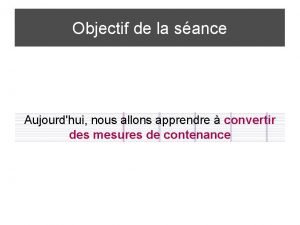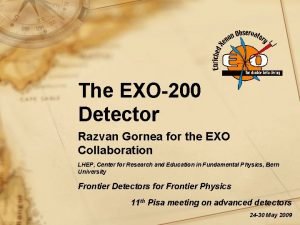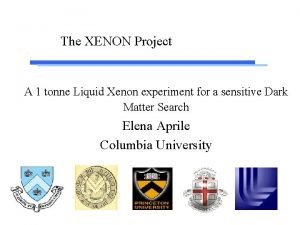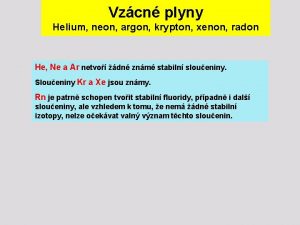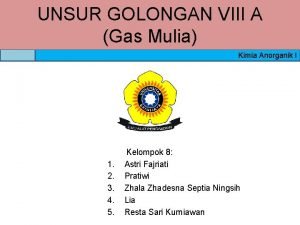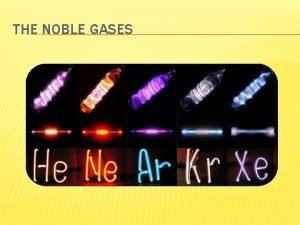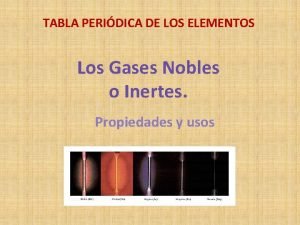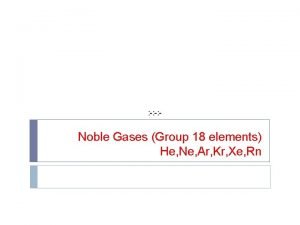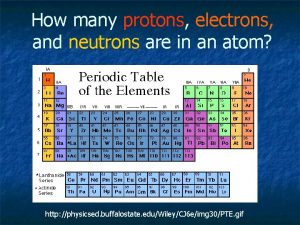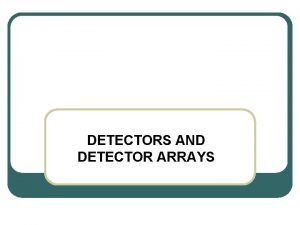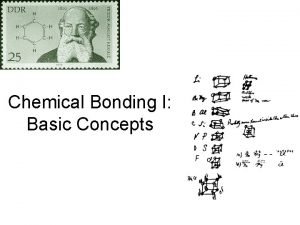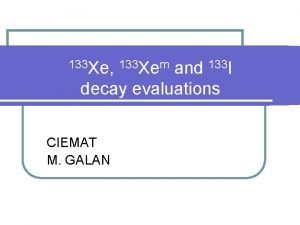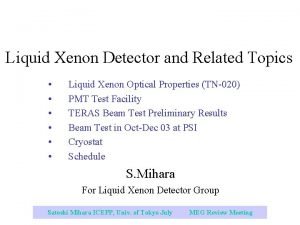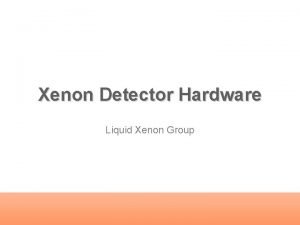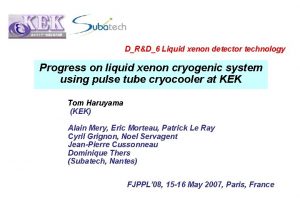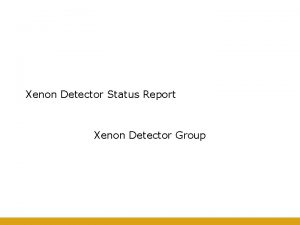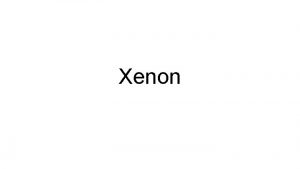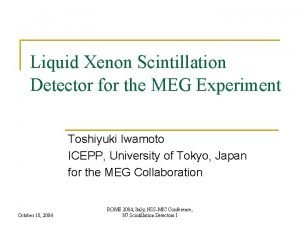The XENON Project A 1 tonne Liquid Xenon















- Slides: 15

The XENON Project A 1 tonne Liquid Xenon experiment for a sensitive Dark Matter Search Elena Aprile Columbia University

The XENON Collaboration • Columbia University: E. Aprile (Principal Investigator) T. Baltz, A. Curioni (graduate student), K-L. Giboni, C. Hailey, L. Hui, M. Kobayashi and K. Ni (graduate student) • Brown University: R. Gaitskell • Princeton University: T. Shutt • Rice University: U. Oberlack • LLNL: W. Craig Elena Aprile Dark Matter 2002

Current and Projected Limits of WIMP Searches • Projection for CDMS Soudan (7 kg Ge+Si) is ~1 event / kg / yr. Similar limits projected for competing experiments in Europe. • It will take a substantial increase in target mass and superior background discrimination power to reach a sensitivity of ~1 event / 100 kg / yr. For a Xe target with <10 ke. V recoil energy threshold this rate corresponds to a WIMP-nucleon s of ~ 10 -46 cm 2 • A 1 tonne XENON experiment approaches this sensitivity, assuming 3. 9 x 10 -5 cts /kg /d /ke. V background rate, 99. 5% discrimination and 10 ke. V recoil energy threshold. Elena Aprile Dark Matter 2002

Liquid Xenon for a Dark Matter Detector Many favorable properties, from high Z (54) and density (3 g/cc) for a compact instrument of flexible design, to high ionization (~60, 000 e/ Me. V) and scintillation yields if highly purified, to only stable isotopes. . . etc but a low energy threshold is essential for a sensitive WIMP detector. Expected rates of WIMP interactions in Xe and other targets as a function of recoil energy threshold for a 100 Ge. V WIMP with a s = 10 -9 pb (from R. Schnee). Elena Aprile Dark Matter 2002

Ionization and Scintillation in Liquid Xenon I/S (electron) >> I/S (non relativistic particle) Elena Aprile Dark Matter 2002

The XENON Experiment : Design Overview Elena Aprile • The XENON design is modular. An array of 10 independent 3 D position sensitive LXe. TPC modules, each with a 100 kg active Xe mass, is used to make the 1 -tonne scale experiment. • The TPC fiducial LXe volume is selfshielded by a few cm thick layer of additional LXe. The active scintillator shield is very effective for charged and neutral background rejection. • One common vessel of ~ 60 cm diameter and 60 cm height is used to house the TPC teflon and copper rings structure filled with the 100 kg Xe target and the ~50 kg Xe for shielding. Dark Matter 2002

The XENON TPC: Principle of Operation • • • Elena Aprile 30 cm drift gap to maximize active target long electron lifetime in LXe demonstrated 5 k. V/cm drift field to detect small charge from nuclear recoils internal HV multiplier (Cockroft Walton type) Electrons extraction into gas phase to detect charge via proportional scintillation (~1000 UV g/e/cm) demonstrated Internal Cs. I photocathode with QE~31% (Aprile et al. NIMA 338, 1994) to enhance direct light signal and thus lower threshold demonstrated PMTs readout inside the TPC for direct and secondary light need PMTs with low activity from U/Th/K Dark Matter 2002

The XENON TPC Signals: Nuclear Recoil Discrimination • • • Redundant information from charge (secondaryl light) signal (S 2) and primary scintillation light (S 1) signal from PMTs and Cs. I photocathode Background (g, e, ) produce electron recoils with S 2/S 1 >>0 WIMPs (and neutrons) produce nuclear recoils with S 2/S 1~0 Depth of interaction Z from timing and XY from c. o. g of PMT signals. 3 D event localization for effective background rejection via fiducial volume cuts Elena Aprile Dark Matter 2002

The Columbia LXe. TPC for Gamma-Ray Astrophysics 30 kg active Xe mass 20 x 20 cm 2 active area 8 cm drift gap with 4 k. V/cm Charge and Light readout for calorimetry and 3 D imaging Elena Aprile 1 st LXe. TPC demonstration in near space Dark Matter 2002

Compton Imaging of Me. V g-ray Sources with a LXe. TPC Elena Aprile Dark Matter 2002

Background Considerations for XENON • and induced background ( 1/2=10. 7 y): 85 Kr/Kr 2 x 10 -11 in air giving ~1 Bq/m 3 Standard Xe gas contains ~ 10 ppm of Kr 10 Hz from 85 Kr decays in 1 liter of LXe. Allowing <1 85 Kr decay/day i n XENON energy band <1 ppb level of Kr in Xe 85 Kr 136 Xe 2 decay ( 1/2=8 x 1021 y): with Q= 2. 48 Me. V expected rate in XENON is 1 x 10 -6 cts/kg/d/ke. V before any rejection • Neutron induced background Muon induced neutrons: spallation of 136 Xe and 134 Xe take 10 mb and Homestake 4. 4 kmwe estimate 6 x 10 -5 cts/kg/d before any rejection reduce by muon veto with 99% efficiency ( , n) neutrons from rock: 1000/n/m 2/d from ( , n) reactions from U/Th of rock appropriate shield reduces this background to 1 x 10 -6 cts/kg/d/ke. V Neutrons from U/Th of detector materials: within shield, neutrons from U/Th of detector components and vessel give 5 x 10 -5 cts/kg/d/ke. V lower it by x 10 with materials selection Elena Aprile Dark Matter 2002

Background Considerations for XENON • -rays from U/Th/K contamination in PMTs and detector components dominate the background rate. For the PMTs contribution we have assumed a low activity version of the Hamamatsu R 6041 ( 100 cts/d ) consistent with recent measurements in Japan with a Hamamatsu R 7281 Q developed for the XMASS group (Moriyama et al. , Xenon 01 Workshop). Numbers are based on Homestake location and reflect 99. 5% background rejection but no reduction due to 3 D imaging and active LXe shield. Elena Aprile Dark Matter 2002

Charge readout with GEMs: a promising alternative • • • High gain in pure Xe with 3 GEMs demonstrated Coating of GEMs with Cs. I 2 D readout for mm resolution See Bondar et al. , Vienna 01 Elena Aprile Dark Matter 2002

Proposed Strategy for XENON • 10 kg prototype with all design parameters of 100 kg module. • Demonstrate electron drift over 30 cm and charge/light readout under high field operation. Test with electron/nuclear recoils. • Study Kr removal techniques (distillation, cryopumping). • Develop and test low activity PMTs (Hamamatsu metal channel and/or Burle MCP based). • Test multi GEMs charge readout in LXe. • Studies of low activity detector materials. • Finalize the design of a 100 kg LXe. TPC after 2 yrs of R&D. • Construction phase of 1 st XENON module starts in 3 rd year. • Enlarge collaboration and start underground operation by 2005. Elena Aprile Dark Matter 2002

Summary • Liquid Xenon is an excellent detector material well suited for the large target mass required for a sensitive Dark Matter experiment. • The XENON experiment is proposed as an array of ten independent, self shielded, 3 D position sensitive LXe. TPCs each with 100 kg active mass. • The detector design, largely based on established technology and >10 yrs experience with LXe detectors development at Columbia, maximizes the fiducial volume and the signal information useful to distinguish the rare WIMP events from the large background. • With a total mass of 1 -tonne, a nuclear recoil discrimination > 99. 5% and a threshold of 10 ke. V, the projected sensitivity for XENON is 0. 0001 events/kg/day in 3 yrs operation, covering most SUSY predictions. Elena Aprile Dark Matter 2002
 Braune tonne
Braune tonne Le tableau des litres
Le tableau des litres Cleanroom cleaning services irvine, ca
Cleanroom cleaning services irvine, ca Xenon project
Xenon project Breakdown in liquid
Breakdown in liquid Lever arm rule liquid liquid extraction
Lever arm rule liquid liquid extraction What liquid freezes the fastest
What liquid freezes the fastest Neon xenon argon
Neon xenon argon Cara pembuatan xenon
Cara pembuatan xenon Xenon chemical properties
Xenon chemical properties Propiedades del xenón
Propiedades del xenón Group 18
Group 18 How to find protons
How to find protons Xenon gas detector ct
Xenon gas detector ct What atoms can have an expanded octet
What atoms can have an expanded octet Xenon 133 decay
Xenon 133 decay

